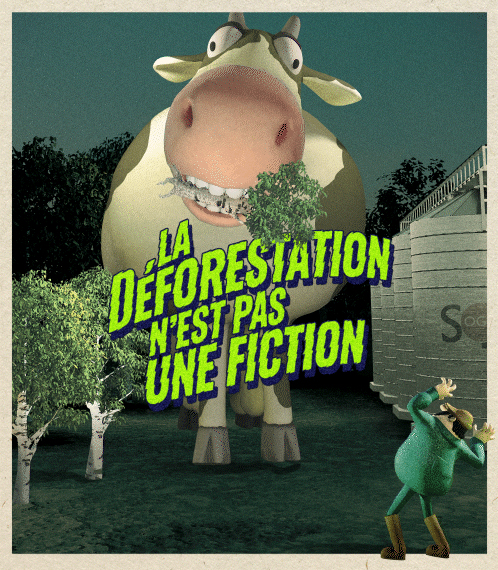Imagined and designed by the Strike agency
Greenpeace France has entrusted the Strike agency with the realization of its new institutional communication campaign on the theme of deforestation, aimed at denouncing the links between industrial agriculture and deforestation.
The goal of this campaign is to raise public awareness of the causes and consequences of one of the greatest ecological disasters: deforestation.
Mandatory mention of © Greenpeace
Deforestation is not fiction
Every two seconds, the equivalent of a football field to a forest disappears from the surface of the planet, dramatically affecting the species that inhabit it. [1].
More than 33,000 fires broke out in the Amazon in August [2]. A sad record since 2010 … particularly worrying when we know that most of these fires are set by industry-related ranchers agro-industrial companies to pave the way for their huge herds of cattle, or from producers of soybeans for export.
A campaign to denounce the role of livestock in deforestation
This campaign aims to denounce the role of livestock (cows, chickens, etc.) in global deforestation, particularly in Brazil.
To increase livestock production and meet the demand for feed in Europe, agribusiness is massively destroying forest ecosystems essential for the balance of the planet, such as the Amazon or the Cerrado in Brazil.
In the Brazilian Amazon, 88% of the cleared land is used to create pastures for livestock [3].
Through a 45-second animated film conceived by the Strike agency and produced by Madame de Sanzillon (QUAD) and an online device, this intervention illustrates in a simple and accessible way the link between industrial agriculture and deforestation.
The challenge: to raise awareness of the importance of reducing the consumption of animal products and to invite action with Greenpeace.
Soy: a major cause of deforestation
Greenpeace is mobilizing around the world against the scourge of deforestation and for the promotion of responsible agriculture.
The demand for soy to feed livestock has exploded in recent years. In response, entire ecosystems such as the Cerrado savannah in Brazil are destroyed and replaced by huge soybean fields, which are then exported around the world.
Europe, complicit in this tragedy
A major importer of raw materials at risk of deforestation, Europe is actively participating in this drama. In Europe, almost 90% of the soy consumed is destined for the feeding of farm animals. [4]. Between 2005 and 2017, EU imports caused the deforestation of 3.5 million hectares of land and over 80% of the tropical deforestation imported from the EU was made up of soybeans. [5].
According to Laurence Veyne, co-director of the Greenpeace France program:
“Forests are essential for human life and biodiversity: nearly two billion people in the world depend directly on them and two thirds of plant and animal species live there [6]. They also act as climate regulators by producing part of the oxygen we breathe and absorbing the carbon emitted into the atmosphere. It is therefore essential to protect them and put an end to deforestation, in particular by reducing our consumption of meat and dairy products ”.
For Jérôme Gonfond, president of the Strike agency:
“With this campaign, we wanted to trigger a confrontation between generations. Let the young parents explain this to their children – No, Deforestation is not an animated film to be seen in the cinema. It is a reality. We wanted to make this information accessible to everyone, so that people can rethink their consumption patterns and change their behavior ”.
For Isabelle Darroman, producer of Madame de Sanzillon:
“On responsible issues, the choice of form is particularly important for a committed message to become engaging. Here, that of animation was evident and director Paul Lavau’s sensitivity was relevant to our audience. We are proud, in Madame, to have accompanied Strike and Greenpeace on this fundamental issue in the face of the emergency ! “
Notes to editors
[1] Source: FAO and UNEP. 2020. The state of forests in the world 2020. Forests, biodiversity and human activity.
[2] Data analyzed by Greenpeace Brazil and collected on: https://queimadas.dgi.inpe.br/queimadas/portal-static/estatisticas_estados/
[3] Source: https://mapbiomas-br-site.s3.amazonaws.com/Nota%20T%C3%A9cnica/Nota_T%C3%A9cnica_UE_07.07.2022.pdf
[4] Source: Kroes H and Kuepper B (2015), p. 9-11. 87% of the soy consumed is destined for animal feed, of which almost 50% for poultry (broilers and laying hens), 24% for pigs, 16% for dairy cows, 7 % for suckler cows, 4% for farmed fish and other production meats. https://www.greenpeace.fr/soja-deforestation/
[6] Source: https://www.un.org/sustainabledevelopment/fr/biodiversity/
Credits
Advertiser: Greenpeace France
Communications Director: Laurence Veyne
Agency: SHOT
President / CCO: Jérôme Gonfond
Strategy Director: Pierre Bellefleur
Creative Director: Rémi Lascault
Copywriter: Jérôme Gonfond
Manufacturer: Madame de Sanzillon
Director: Paul Lavau
Producer: Isabelle Darroman
Coordination: Audrey Tato and Louise Leroy
Rigging: Hadrien Farre
Animation: Julien Loth
Lighting: Jonathan Breuer
Composition: Ewald Aloeboetoe & Estelle Chesneau
Post-production: Fix Studio
VFX Producer: Cédric Herbet
VFX Production Manager: Maeva Bonté
VFX Coordinator: Your Borg
CG Supervisor: Olivier Osotimehin
2D Supervisor: Benjamin Laborde
Modeling / Shading: Hugo Garnier
Son of production: IL
Music supervision: Antoine Le Guern
About STRIKE – Committed independent creative agency, founded in September 2019, combining strategy and creative expertise to create impactful and meaningful campaigns.
About Madame de Sanzillon – QUAD group entity dedicated to creating and producing committed content that highlights the civic role of brands through inspiring new stories.
Contact with the media
Greenpeace France
Eléonore Thélot | +33 (0) 7 72 50 56 36 | [email protected]
TO HIT
Margaux Fievet | +33 (0) 6 26 42 76 70 | [email protected]

